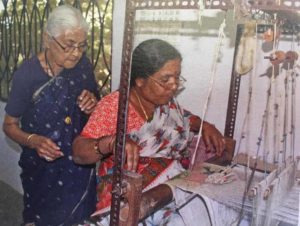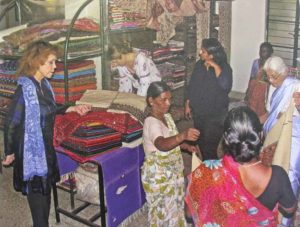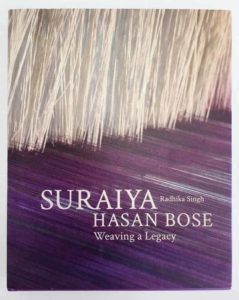
SURAIYA HASAN BOSE: A LIFE WELL LIVED
When I think of Suraiya Apa, as she is endearingly called by her friends and colleagues, the first thought that comes to mind is… now, here is a life that’s well lived! Her genuine devotion to her craft and keen desire to make a difference, along with her overall gentle and humble manner, have touched me on many levels.

I first met Suraiya Apa in 2007, when I had just moved to Hyderabad from the US. Having taken a break from work to raise my two kids, I had the time to pursue learning more about Indian art and design. One thing led to another and soon enough, I found myself at Suraiya Apa’s shop on the outskirts of Hyderabad, touching the wide array of woven textiles that India offers such as Venkatgiti, Paithani, Gadwal and other traditional designs. Suraiya introduced herself and then patiently began to teach me the finer nuances of weaving, like the difference between single and double ikat or the specific types of Kalamkari work on cloth.
Over the years, Suraiya Apa and I formed a close association. I always make sure to visit her when I am in Hyderabad, and she always surprises me with her spirit. She is in her 90’s now, and sadly her memory is not the same. Still, she slowly walks to the shop every day and tends to clients from 10am to 5pm.

Born and raised in Hyderabad, Suraiya studied textiles at Cambridge University, which was no small achievement for a young woman in the 1940s. She returned to Hyderabad to work as the assistant manager at the Cottage Industries Emporium, a government organization founded by her father to support the preservation and celebration of traditional Indian textiles. In the late 1950s, she was recruited to work for the newly formed Handloom and Handicrafts Export Corporation in Delhi, an agency of the Government of India’s Ministry of Textiles established to export Indian woven products. During her time there, Suraiya worked with legendary Indian textile artists including Martand Singh, Lakshmi Jain and Kamaladevi Chattopadhyay.
She spent two decades in Delhi before returning to Hyderabad again in the 1970s. Her uncle, Abid Hussain Safrani, had purchased 10 acres of land outside the city. Suraiya soon set up a school in his name so that children from nearby villages could get a quality education. It was also on this land that she set up her influential loom unit — in this studio, she revived the complex art of ‘himru’ and ‘mashru’ weaving, using her experience to market these ancient weaves to modern clients.
Suraiya then became a key supplier of Fabindia, among other prominent companies, essentially rescuing multiple textile arts by herself. She is such a force in Indian textile industry that in 2015, the prestigious Victoria and Albert Museum in London exhibited her designs, and in February 2019, Fabindia released a gorgeous coffee table book on her life and accomplishments.

Through her tireless advocacy of traditional weaving, she truly changed the course of history for Indian fabrics and preserved these meaningful crafts for the next generation. (She has certainly inspired me to support traditional Indian art forms in my own way, by promoting Kalamkari and Madhubani (Mithila) paintings for sale here at Laasya Art.)
If you are ever in Hyderabad and looking to buy Indian textiles or just to learn more about traditional Indian weaving, a visit to Suraiya Apa’s store is an absolute must. You can find her at this address:
Suraiya’s
1-86, Durga Hussain Shahwali
PO Golcondo, Hyderabad
Tel: + 1 040 32588543/42
I hope you cherish your time with Suraiya Apa, a true champion of Indian culture and history — there are few people in the world like her.
— Sonia Nayyar Patwardhan

Leave a Reply
You must be logged in to post a comment.